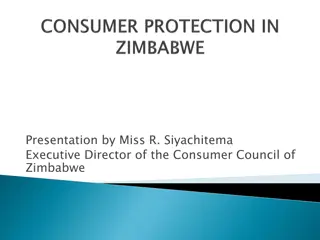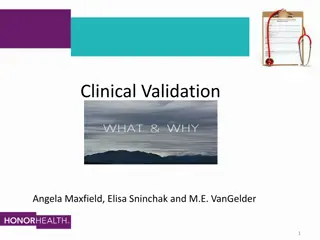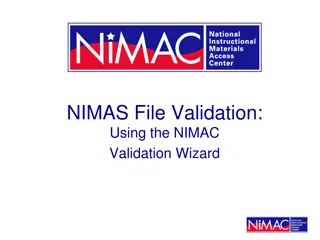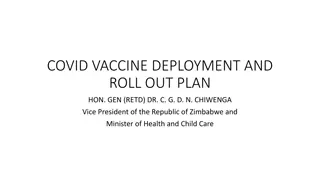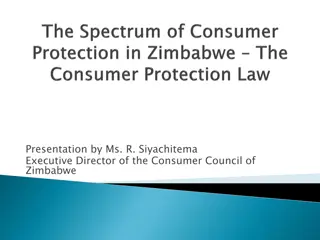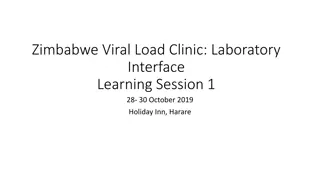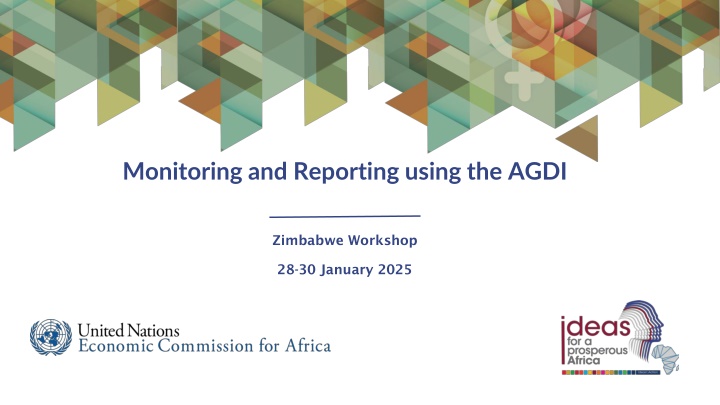
Monitoring and Reporting using AGDI: Human Rights, Indicators, and Obligations
Explore the essential aspects of monitoring and reporting in the context of human rights using the African Gender and Development Index (AGDI). Learn about human rights definition, rights holders, duty bearers, monitoring obligations tied to international treaties, and more in this comprehensive workshop outline.
Download Presentation

Please find below an Image/Link to download the presentation.
The content on the website is provided AS IS for your information and personal use only. It may not be sold, licensed, or shared on other websites without obtaining consent from the author. If you encounter any issues during the download, it is possible that the publisher has removed the file from their server.
You are allowed to download the files provided on this website for personal or commercial use, subject to the condition that they are used lawfully. All files are the property of their respective owners.
The content on the website is provided AS IS for your information and personal use only. It may not be sold, licensed, or shared on other websites without obtaining consent from the author.
E N D
Presentation Transcript
Monitoring and Reporting using the AGDI Zimbabwe Workshop 28-30 January 2025
Outline 1. Human rights 2. Monitoring and reporting 3. Indicators 4. The African Gender and Development Index (AGDI) 5. Gender Status Index 6. Women s Progress Scoreboard Based on: ECA (2023). The African Gender and Development Index Technical Note. OHCHR (2012). Human right indicators: A Guide to Measurement and Implementation.
1.1. Human rights: Definition Human rights are: o Guaranteed to all human beings by virtue of being humans. o Universal apply to all human beings, regardless of race, colour, sex, ethnic or social origin, religion, language, nationality, age, sexual orientation, disability or any other distinguishing characteristic. o Inalienable - cannot be alienated from an individual or group except under clearly defined legal circumstances. o Interrelated - the realization of any one right is a function of the realization of the others. o Interdependent the enjoyment of any one right is dependent on the realization of the others. o Indivisible all human rights are equally important.
1.2: Human rights: Rights holders and duty bearers Human beings are rights holders. Responsibilities of States (as duty bearers) to right holders: o Responsibility to respect - Must refrain from interfering with the enjoyment of human rights by individuals and groups. o Responsibility to protect - Must prevent non-state actors or third parties from violating the human rights of individuals. o Responsibility to fulfil - Must take positive measures, including adopting appropriate legislation, policies and programmes, to ensure the realization of human rights.
2.1. Monitoring and reporting obligations: Binding Human rights treaties International Covenant on Civil and Political Rights, 1966 International Covenant on Economic, Social and Cultural Rights, 1966 Convention on the Elimination of all Discrimination Against Women (CEDAW), 1979 Convention on the Rights of the Child, 1989 African Charter on the Rights of the Child, 1990 Optional Protocol to the Convention on the Elimination of All Forms of Discrimination against Women, 1999 Protocol to Prevent, Suppress and Punish Trafficking in Persons, Especially Women and Children, 2000 Protocol to the African Charter on Human and People s Rights on the Rights of Women in Africa (Maputo Protocol), 2003 SADC Protocol on Gender and Development, 2008 Ratification status (1991) (1991) (1991) (1990) (1995) x (2013) (2008) (2009)
2.1. Monitoring and reporting obligations: Binding Example: CEDAW States Parties are obligated to submit reports on the measures they have adopted to give effect to the provisions of the Convention for consideration by the Committee on the Elimination of Discrimination against Women. o The initial report within a year. o Periodic reports every four years. Civil society organizations usually submit a separate shadow report to the Committee. The Committee examines the reports and issues concluding observations, on positive and negative aspects of a State Party s implementation of the Convention.
2.2. Monitoring and reporting obligations: Non-binding Beijing Declaration and Platform for Action, 1994 o National reviews every 5 years. o United Nations Resolution E/RES/2022/5 (Beijing+30 review): Calls upon all States to undertake comprehensive national-level reviews of the progress made and challenges encountered in the implementation of the Beijing Declaration and Platform for Action ...) The 2030 Agenda for Sustainable Development and the Sustainable Development Goals, 2015 o Paragraph 79: We also encourage member states to conduct regular and inclusive reviews of progress at the national and sub-national levels which are country-led and country- driven. o Agenda 2063 o Solemn Declaration
3.1. Indicators: Quantitative versus qualitative Quantitative indicators are expressed in quantitative form. o Example: Indicator Unit Female Male GSI Source Year The proportion of women who are Cabinet Ministers % total of 23.3 76.7 0.30 PoZ 2023 Qualitative indicators are expressed in narrative form. o Example: The status of ratification of the Convention on the Elimination of all Discrimination against Women. Score: 0 - not ratified 1 ratified with reservations 2 - Ratified without reservations
3.2. Indicators: Human rights commitments-efforts- outcomes Outcome indicators: assess the results achieved Structural indicators: assess the commitments made Process indicators: assess effort made in meeting its commitments SDG indicator 5.3.1: Proportion of women aged 20 24 years who were married or in a union before age 15 and before age 18 Ratification Adoption of domestic law Institutional mechanisms Policy framework and strategies Programme of action that can be implemented with: Allocation of financial and human resources Training of personnel involved in implementation Cases reported and the share addressed SDG indicator 5.3.2: Proportion of girls and women aged 15 49 years who have undergone female genital mutilation/cutting, by age o Objectives o Plan of action to meet objectives o Time frame o Targets/benchmarks for accountability Awareness measures Involvement of civil society organizations
4.1 AGDI: Objectives 1. Monitor progress made meeting commitments on gender equality and women s empowerment. 2. Report on the status and progress on achieving gender equality and women s empowerment. 3. Identify and prioritize bottlenecks to achieving gender equality. 4. Identify policy actions to address bottlenecks to achieving gender equality.
4.2. AGDI: Mapping womens human rights Mapping ICCPR and ICESCR vs. CEDAW, Beijing Platform for Action, Maputo Protocol, SDGs, ILO Conventions Eight human rights Rights to non-discrimination and equality, including rights to marry and rights in marriage Right to live free from gender-based violence against women Right to education Right to health Right to work and rights at work Right to an adequate standard of living, including right to food and right to social security Right to participate in political and public life Right to a healthy and sustainable environment A B C D E F G H
4.3. AGDI: Components (commitment-effort-outcome) A. Women s Progress Scoreboard (qualitative indicators) Outcome indicators: assess the results achieved Structural indicators: assess the commitments made Process indicators: assess effort made in meeting its commitments Share of members of parliament, by sex Ratification Adoption of domestic law Institutional mechanisms Policy framework and strategies Programme of action that can be implemented with: Allocation of financial and human resources SDG indicator 5.3.2: Proportion of girls and women aged 15 49 years who have undergone female genital mutilation/cutting, by age Training of personnel involved in implementation Cases reported and the share addressed o Objectives o Plan of action to meet objectives o Time frame o Targets/benchmarks for accountability Awareness measures B. Gender Status Index (quantitative indicators) Involvement of civil society organizations
5. Gender Status Index Outcome indicators: assess the results achieved. Provides a quantitative assessment of gender equality. Comparison: Female performance vs. male performance. Aligned with the Minimum Set of Indicators for Africa. 41 indicators organized around 8 human rights.
5. Gender Status Index (ZGDI) Indicator Unit Female Male GSI Data source Year Primary enrolment rate (net) Proportion of seats held by women in Parliament (National Assembly) Proportion of women who are judges of higher courts % 88.94 87.72 1.01 EMIS 2022 % total of 11.00 89.00 0.12 PoZ 2023 % total of 58.70 41.30 1.42 MoLG 2022 Primary education: gender parity Parliament: disparity in favour of males. High court judges: Disparity in favour of females.
6.1 Womens Progress Scoreboard: Approach 1. 25 indicators based on human rights treaties, declarations, women s rights issues and gender-relevant SDG targets 2. organized around 8 human rights. 3. 7 structural and process performance measures ... 4. scored on a three-point scale 5. Scoring criteria sharply defined.
6.2. Womens Progress Scoreboard: Performance Measures Rate indicators (0, 1, 2) across seven structural and process performance measures: 1. Ratification and reporting Structural 2. Law and policy commitment 3. Development of a plan 4. Institutional mechanism 5. Resources (Budget, human resources, training, and capacity enhancement) Process 6. Involvement of civil society, Information, and dissemination 7. Monitoring and evaluation
6.3. Womens Progress Scoreboard: Indicators A. Rights to non-discrimination and equality, includes right to marry and rights in marriage (4 indicators) 1. Gender equality provision in the constitution (Article 2 of CEDAW) 2. No impediment to gender equality due to religious, traditional or customary regulations 3. Gender equality in family code (Article 16 (1) of CEDAW) 4. Optional Protocol to CEDAW
6.3. Womens Progress Scoreboard: Indicators B. Right to live free from gender-based violence against women and girls (6 indicators) 5. Law on gender-based violence against women and girls 6. Marital rape 7. Sexual harassment 8. Prohibition of child marriage (Article 16 (2) of CEDAW) 9. Prohibition of female genital mutilation 10. Protocol to Prevent, Suppress, and Punish Trafficking in Persons, especially in Women and Children, 2000
6.3. Womens Progress Scoreboard: Indicators C. Right to education (2 indicators) 11. Reduce female student drop-outs rates (Article 10(f) CEDAW)) 12. Access to Science, Technology, Engineering and Mathematics (STEM) subjects and ICT
6.3. Womens Progress Scoreboard: Indicators D. Right to health (3 indicators) 13. Maternal mortality 14. Unmet needs for family planning 15. Safe abortion
6.3. Womens Progress Scoreboard: Indicators E. Right to work and rights at work (4 indicators) 16. Remuneration, 1951 (C100)) 17. Parental leave (Maternal leave ILO Convention on Maternity Protection, Rec. 191) 18. Childcare (ILO Convention No. 156 with Family Responsibilities on Workers, 1981) 19. Transition from the Informal to the Formal Economy (ILO Recommendation, 2015 (No. 204)) Equal wages (ILO Convention on Equal
6.3. Womens Progress Scoreboard: Indicators F. Right to an adequate standard of living, including right to food and right to social security (2 indicators) 20. Support for women s ownership 21. Extension services/training
6.3. Womens Progress Scoreboard: Indicators G. Right to participate in political and public life (3 indicators) 22. National machinery for the advancement of women 23. Support for women s quotas and affirmative action 24. United Nations Security Resolutions 1325, 1820, 1888 and 1889 on Women, Peace and Security
6.3. Womens Progress Scoreboard: Indicators H. Right to a healthy and sustainable environment (1 indicator) 25. mainstreamed in policies on climate change Gender and women-specific issues


